Top 10 Remote Backend Job Boards 2025
Remote backend jobs are booming in 2025, with niche platforms making it easier for developers to find roles suited to their skills. Here's a quick rundown of the top job boards for remote backend developers:
- Remote Jobs For Software Engineers: Aggregates listings from 100+ boards, advanced filters for tech stacks, and tiered pricing starting at $0.
- Toptal: Elite network for top-tier developers, offering high-paying freelance projects with a rigorous screening process.
- Wellfound (formerly AngelList): Focused on startups, with equity details and free access for job seekers.
- Arc.dev: Curated matches for vetted developers, connecting them with U.S. and European companies.
- Built In: Tech-specific roles with insights into company culture and salary details.
- Upwork: Global freelance marketplace with flexible project-based opportunities.
- Fiverr: Gig-based platform for fixed-price backend services.
- LinkedIn: Largest professional network with advanced search tools and networking opportunities.
- Stack Overflow Jobs: Discontinued in 2022 but historically popular for developer-focused roles.
- We Work Remotely: Remote-only platform with global listings and free access for job seekers.
Quick Comparison:
| Platform | Best For | Pricing (Job Seekers) | Key Features |
|---|---|---|---|
| Remote Jobs For Software Engineers | All backend developers | Free to $19/month | Aggregates 100+ boards, tech stack filters |
| Toptal | Senior developers | Free | High-end clients, rigorous vetting |
| Wellfound | Startup enthusiasts | Free | Equity details, startup focus |
| Arc.dev | Mid to senior developers | Free | Curated matches, global reach |
| Built In | Tech-focused developers | Free | Salary insights, company culture details |
| Upwork | Freelancers | Free (fees apply) | Global reach, flexible project work |
| Fiverr | Service providers | Free (fees apply) | Fixed-price gigs, global audience |
| All professionals | Free to Premium | Networking tools, advanced filters | |
| Stack Overflow Jobs | Historical developers | N/A | Discontinued in 2022 |
| We Work Remotely | Remote-first developers | Free | Remote-only roles, global reach |
Key Takeaway: Whether you're a freelancer, a senior developer, or exploring startup roles, these platforms offer tailored solutions for finding remote backend opportunities. Start with those that align with your skills and career goals.
1000 Rejection Emails to Remote Job Offer | How to get Remote Jobs in 2024? | Kushal Vijay
1. Remote Jobs For Software Engineers
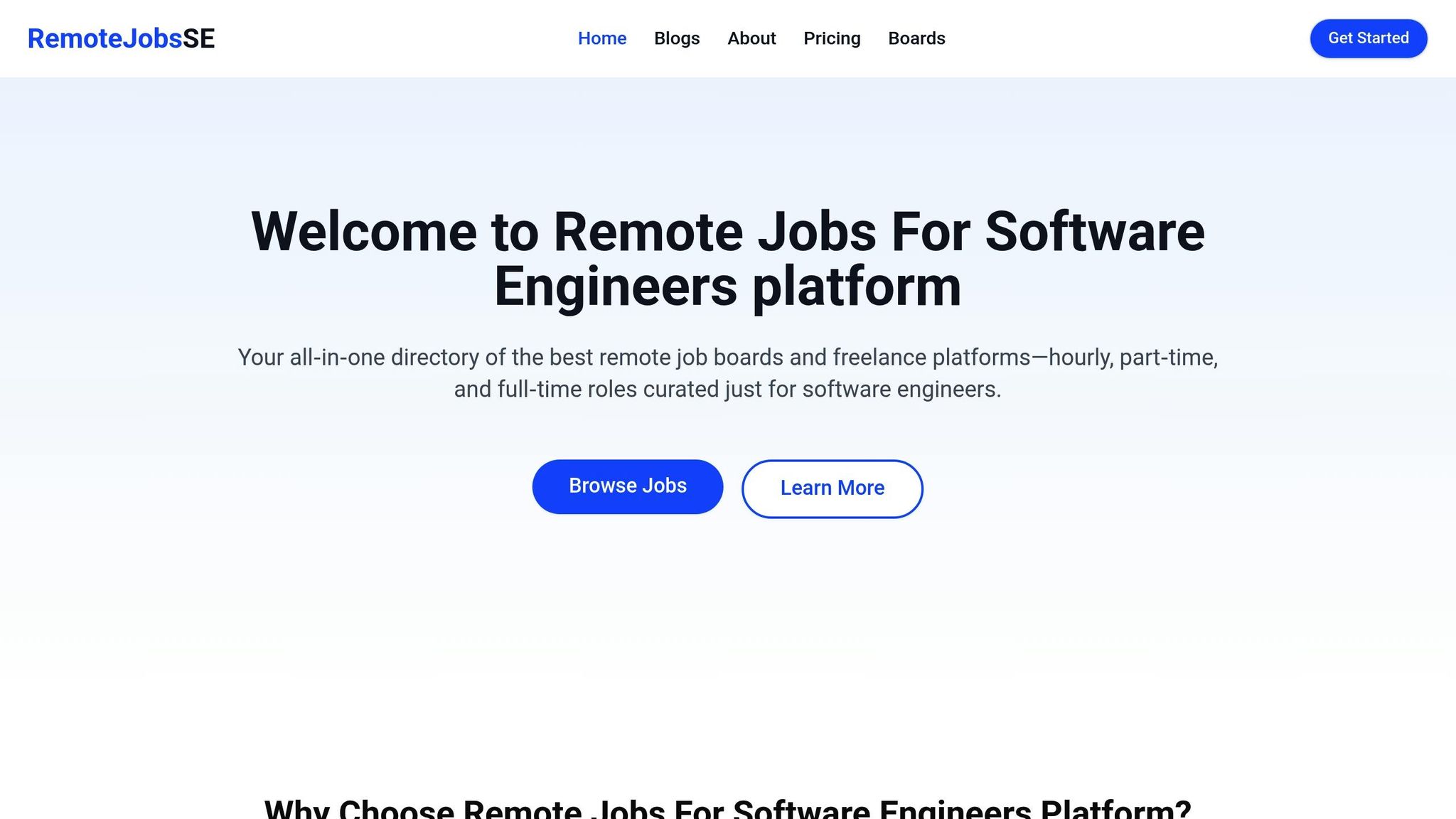
Remote Jobs For Software Engineers, created by Artur Abdullin, brings together opportunities from more than 100 carefully selected job boards and freelance platforms, offering a daily updated collection of listings.
Tailored Listings for Backend Developers
This platform focuses on remote software engineering roles, catering to professionals at all levels - from those just starting out to seasoned senior backend engineers. It highlights positions at dynamic startups, VC-backed companies, remote-first tech teams, and well-established firms.
With job tracking across 10,000 leading companies, the platform provides access to exclusive opportunities. These range from startups hiring their first backend developer to Fortune 500 companies growing their remote workforce.
Advanced Search Tools
Backend developers can take advantage of advanced filters to find jobs that align with their skills. The platform supports searches based on specific tech stacks like Python, JavaScript, React, Go, SQL, and Node.js - key technologies in backend development. This makes it easier to pinpoint roles that match individual expertise.
Users can also refine searches by experience level, job type (permanent or contract), and specific areas of specialization. Considering that 86% of developers already work remotely and 43% view remote work as essential during their job search [2], these filters are a game-changer. Additional options allow developers to sort by company size and remote work policies, ensuring they find roles that align with their personal priorities.
The platform goes further by focusing on remote-friendly policies and offering competitive U.S.-based opportunities.
Connecting Developers Globally
Although the platform prioritizes U.S.-based remote roles, it also links developers with companies that embrace remote-first work cultures. This U.S. focus opens up access to positions with attractive salaries, particularly important given that the median tech wage in 2022 was 125% higher than the national median wage [3].
Flexible Pricing Options
Remote Jobs For Software Engineers offers tiered pricing to ensure accessibility. The free plan provides basic features, including limited search filters and standard job alerts. For $19 per month, the Pro plan unlocks advanced filters, personalized job alerts, and early access to new listings.
The Enterprise plan, priced at $49 per month, includes API access, dedicated support, and custom integrations for teams. This structured pricing ensures that individual developers can find quality opportunities without breaking the bank, while organizations can leverage premium tools for their hiring needs.
2. Toptal

Toptal is more than just a job board; it’s an exclusive network that connects highly skilled backend developers with remote opportunities offering premium pay. What sets it apart is its rigorous screening process - accepting fewer than 3% of applicants - to ensure only the most qualified professionals are matched with top-tier client projects [4]. This commitment to quality defines Toptal's entire approach.
Curated Listings for Backend Roles
Toptal focuses on pairing clients with backend freelancers through a meticulous matching system. This process ensures both technical compatibility and alignment with budget expectations [4]. Developers working through Toptal often find themselves collaborating on projects for Fortune 500 companies and Silicon Valley startups, enjoying competitive compensation and challenging work.
For instance, the platform highlights its commitment to excellence with statements like:
"When you hire back-end architects with Toptal, you'll always work with world-class, custom-matched back-end developers ready to help you achieve your goals." [4]
The numbers back this up: backend developers on Toptal boast an average rating of 4.9 out of 5.0 from over 17,000 reviews, and the platform reports a 98% trial-to-hire success rate [4][5].
Global Reach and Remote-Friendly Features
Toptal operates as a fully remote network, spanning over 70 countries, making it a top choice for backend professionals seeking global opportunities [6]. Its remote-first setup allows developers to work from anywhere with just a laptop and reliable WiFi. Additionally, Toptal handles administrative tasks like billing and invoicing, letting developers focus on their work [7][8].
Guillaume Fradin, a Verified Expert in Engineering, shared his experience with Toptal:
"Toptal has enabled me to meet and work with clients from diverse industries and with very different requirements. They were all a pleasure to work with, and this has allowed me to push myself, keep learning, and benefit from a flexible environment." [7]
Beyond work, Toptal fosters global connections through conferences, coworking events, and workshops, enriching the professional experience for its members.
Pricing and Accessibility for Job Seekers
Toptal’s pricing model is developer-friendly, allowing backend professionals to set their own hourly rates, which start at $60 per hour depending on the project [4]. Developers also maintain full control over their schedules, and the platform encourages repeat engagements with clients, helping to build steady, long-term income streams.
For backend developers looking to collaborate on high-value projects with established companies, Toptal offers an exceptional pathway - though the competitive selection process demands top-tier skills and expertise.
3. Wellfound
Wellfound (formerly AngelList) has become a go-to platform for backend developers looking for remote opportunities with startups and growth-stage companies. Its features are tailored to meet the needs of developers adapting to the remote work landscape in 2025.
Advanced Filtering Options
Wellfound takes job searches to the next level with its dual-tier filtering system. This allows developers to separate must-haves from nice-to-haves when searching for roles. You can filter by programming languages, frameworks, technical stacks, and even compensation - covering both salary ranges and equity percentages. Beyond that, filters for work type, experience level, and company details like funding stage and team size make it easy to find the right fit.
The platform also includes a keyword search to help developers find niche technologies and specific architectural patterns, ensuring a more precise match for their skills and interests.
Global Reach and Remote-friendly Features
With over 400,000 international job seekers on the platform [9], Wellfound is a strong option for developers seeking global remote roles. It addresses common challenges for international candidates by offering filters for jobs that don’t require visa sponsorship or relocation. Users can also specify their preferred time zones and remote work culture, making it easier to find roles that align with their lifestyle.
Additionally, Wellfound provides tools like video resumes, which allow developers to highlight their communication skills and technical enthusiasm - qualities that are crucial for remote work success.
Pricing and Accessibility for Job Seekers
One of Wellfound’s standout features is that it’s completely free for job seekers. Developers can take full advantage of its advanced filtering options, customize their profiles, and apply directly to positions without any cost. Plus, they can choose to have their profiles featured in curated lists shared with companies actively hiring remote talent, boosting their visibility and chances of landing the perfect role.
4. Arc.dev
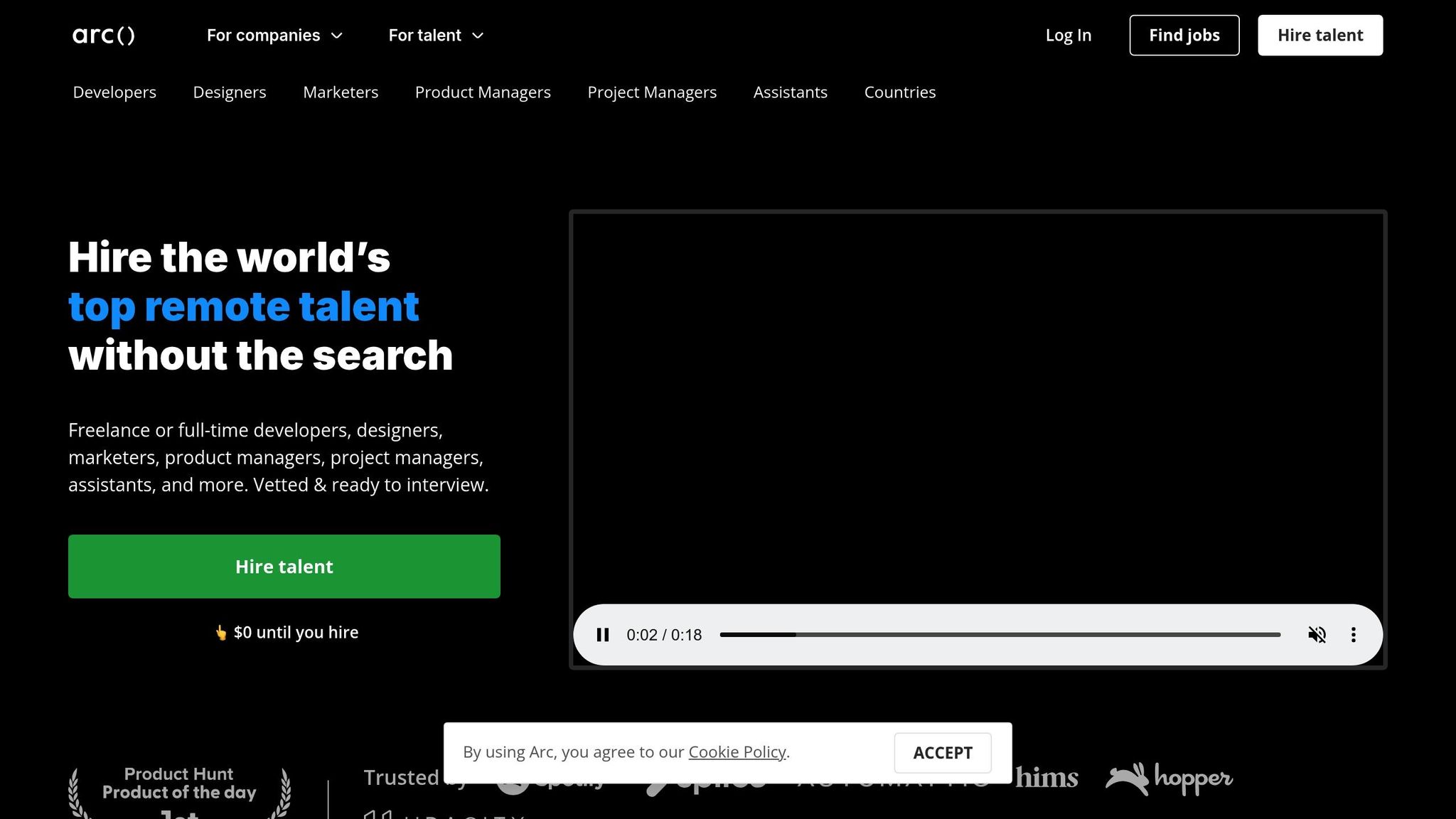
Arc.dev is a high-tier talent marketplace that connects backend developers with remote opportunities at tech companies in the U.S. and Europe. Unlike standard job boards, Arc.dev operates as an exclusive network, accepting only the top 2.3% of applicants[12].
Tailored Backend Developer Opportunities
Arc.dev uses AI-driven screening[11] to match backend developers with roles that fit their skills and experience, avoiding generic job postings. The platform supports both freelance and full-time positions, with freelance rates typically ranging from $60–$80 per hour[11]. For hiring, Arc.dev boasts impressive speeds - full-time placements are completed in under 14 days, while contractor roles are filled within 72 hours[12].
A Truly Global Network
With a community of 450,000 professionals spanning 190 countries[13], Arc.dev offers backend developers access to global opportunities. The platform focuses on connecting developers with remote roles in U.S. and European tech companies[14], enabling them to tap into international markets and competitive pay scales. Candidates undergo a thorough vetting process to assess both their technical skills and English proficiency[13], ensuring smooth collaboration in distributed teams.
"I strongly recommend Arc to friends and family because it's been a great freelancing experience for me. Arc does a great job making sure clients get expert talent and candidates get great positions." – Carlos from Guatemala[14]
Arc.dev goes beyond job placement by offering resources like resume optimization, interview preparation, and salary negotiation guidance[10][14]. These features, combined with a transparent pricing structure, make it a comprehensive platform for job seekers.
Free Access for Developers
Arc.dev is entirely free for developers[14], making premium opportunities accessible without financial hurdles. Companies hiring through the platform pay a fee equal to 20% of a developer’s first-year salary for full-time roles[11]. To join, developers must pass a rigorous verification process, which includes an English assessment and a technical evaluation[14]. This ensures only top-tier professionals are accepted into the network.
The platform's dedication to quality extends to its support services. Users frequently commend the Arc.dev team for being responsive and helpful[12]. By handling project matching, client communication, and payment logistics, Arc.dev allows backend developers to focus on delivering their best work[12].
5. Built In
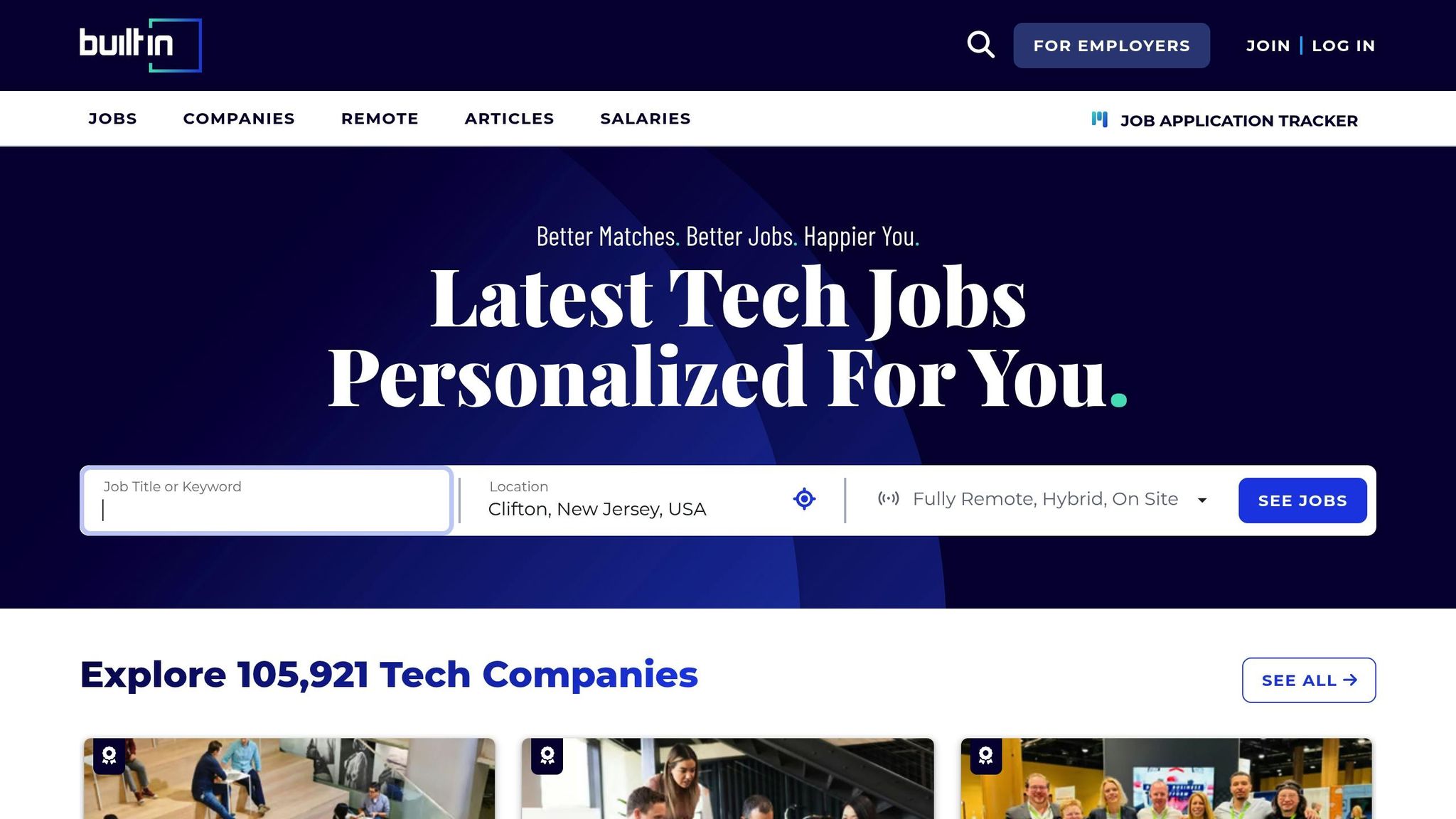
For backend developers seeking opportunities, Built In stands out as a platform dedicated to connecting tech professionals with relevant roles. With its tech-focused job board, it includes a specific section for remote positions, offering a streamlined way to find backend jobs at U.S. companies.
Tailored Listings for Backend Developers
Built In zeroes in on tech roles, which means backend developers won’t need to wade through unrelated job postings. The platform’s curated listings are designed to match candidates with positions that align with their expertise. To make the search even easier, Built In provides advanced filters, allowing users to narrow down options based on job category, required skills, experience level, industry, company type, and size. For those seeking flexibility, selecting "Remote" as the location ensures a focus on remote-friendly roles.
Remote-Friendly and Company Insights
Built In simplifies the search for remote backend jobs by offering a dedicated filter for "Remote" positions. Beyond job listings, the platform provides detailed insights into company culture, giving candidates a better understanding of whether a prospective employer genuinely supports remote work. This transparency helps developers make informed decisions about where to apply.
6. Upwork
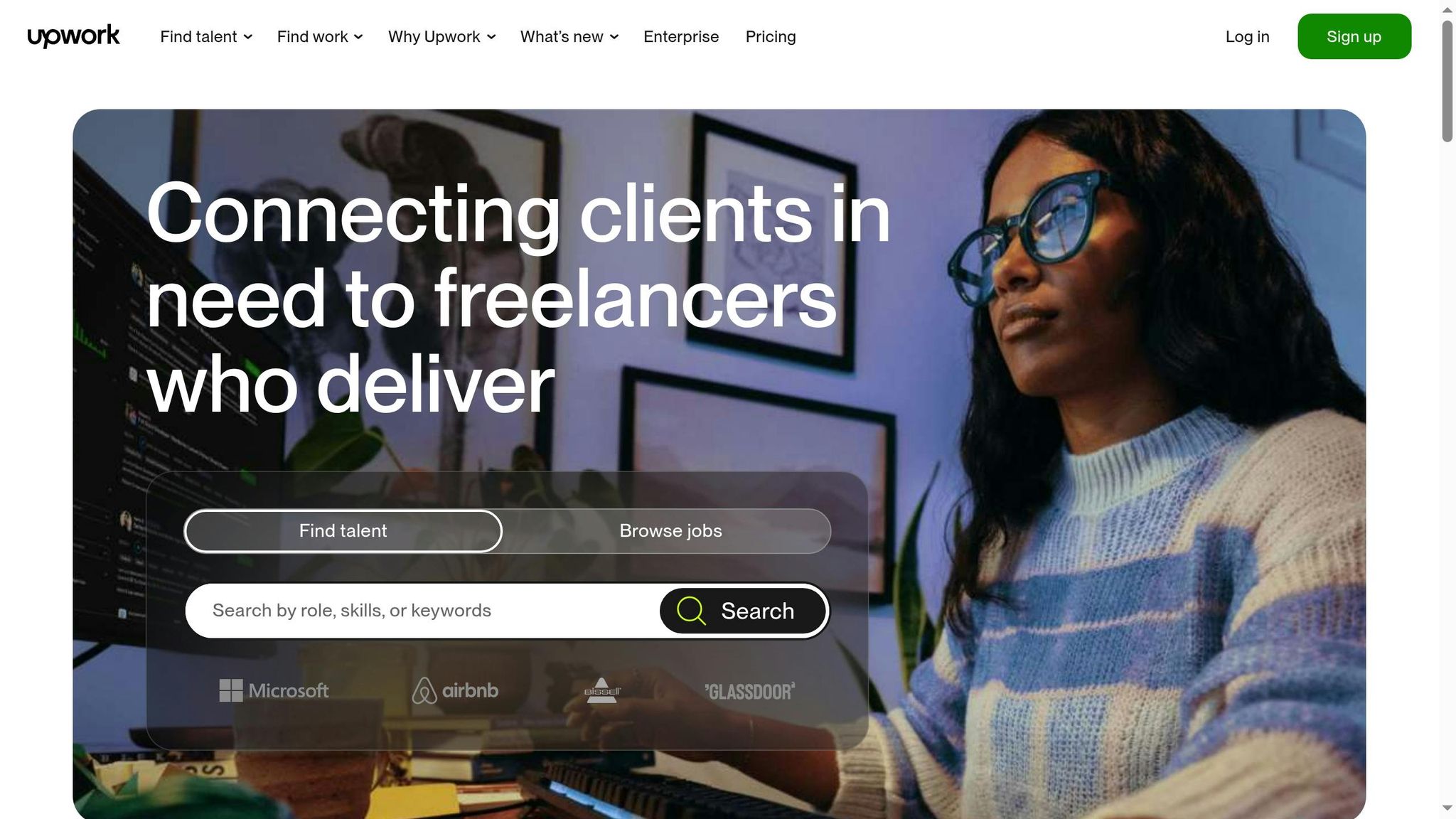
Upwork is a global platform that connects backend developers with remote projects. With a network of over 12 million freelancers spanning more than 125 categories, it offers a wealth of opportunities for developers seeking remote work [16].
Advanced Filtering Options
Upwork’s intelligent matching system uses advanced algorithms to pair backend developers with projects that align closely with their skills [15]. This system simplifies the search process, ensuring developers find work that matches their expertise. By leveraging this technology, developers can tap into Upwork’s extensive global network with greater ease.
Global Reach and Remote-Friendly Features
Operating across 250 countries, Upwork connects backend developers with international clients, reflecting the growing global demand for remote talent [17]. The platform boasts 814,000 active clients, each spending at least $5,000 annually, highlighting the serious investment in skilled professionals [17]. With $4.1 billion in global sales, the volume of work available on Upwork is significant [17].
The platform also offers a secure and comprehensive remote-work environment. Features like identity verification and payment protection provide freelancers with peace of mind when pursuing opportunities.
"Upwork provides an umbrella-level of security. I can see a talent's work history and ratings. I can hold payments in escrow. I can communicate through Upwork Messages instead of working through my email address." - Kim Darling, Emerald Tiger [18]
Pricing and Accessibility for Job Seekers
Upwork is accessible to developers at any stage of their career, thanks to its transparent pricing structure. Creating a profile is free, but the platform charges a service fee ranging from 0–15% of earnings per contract, depending on factors like supply and demand [19]. Minimum rates are set at $3.00 per hour for hourly jobs and $5.00 for fixed-price projects [19]. To help developers plan their earnings, Upwork provides a Fee Calculator, enabling them to price their services competitively while accounting for platform fees.
sbb-itb-7cee4ec
7. Fiverr
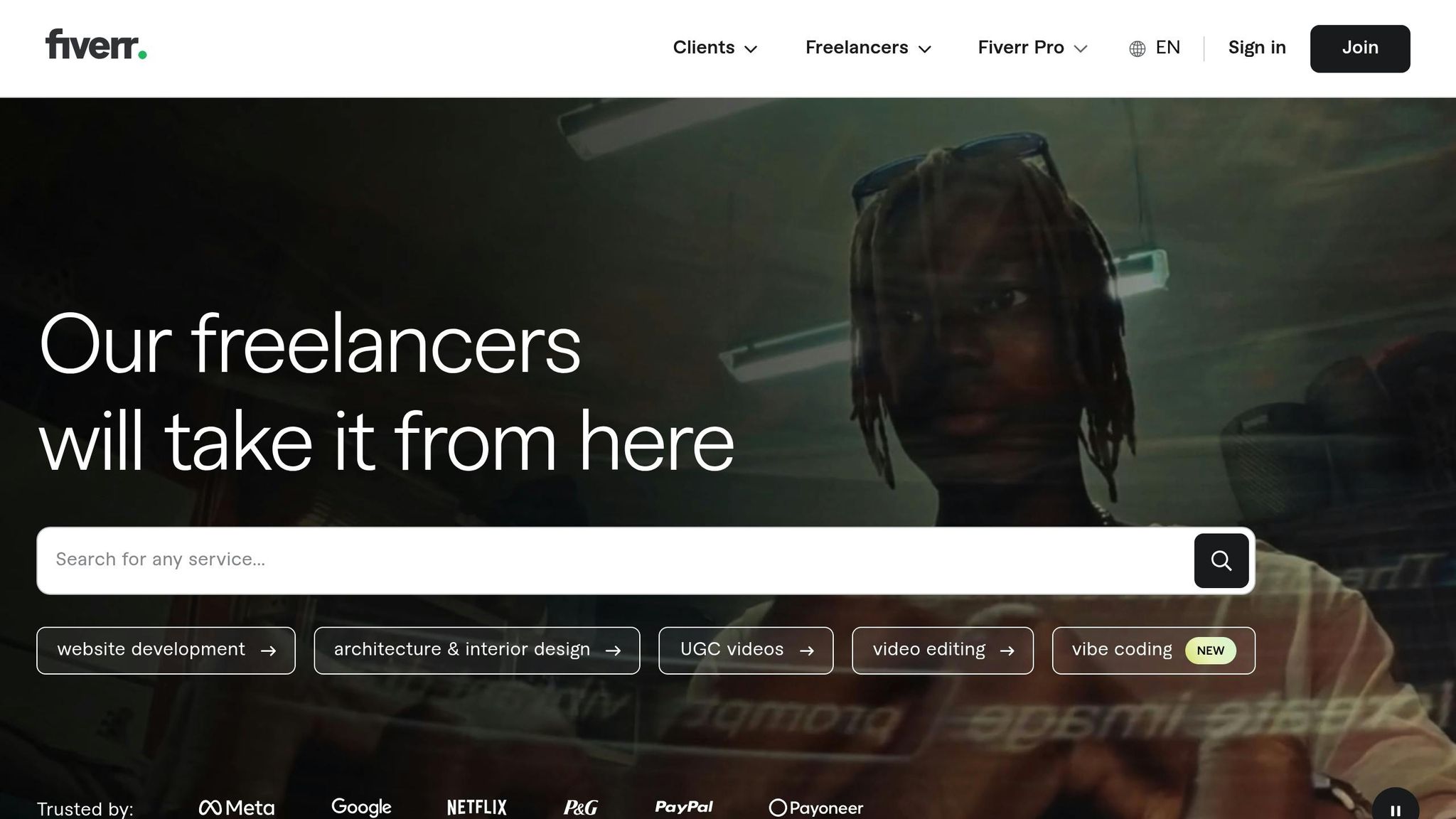
Fiverr takes a unique approach to connecting backend developers with clients, offering a gig-based platform that emphasizes flexibility. It serves as a global marketplace where freelance backend developers can offer fixed-price services tailored to specific technical needs. These services include server-side application development, database management, API development, e-commerce solutions, and CMS customization [20].
Showcasing Expertise Through Curated Profiles
Backend developers on Fiverr can create detailed service profiles that highlight their skills and experience. These profiles often include portfolios, client reviews, ratings, and professional badges, giving potential clients a clear view of a developer's capabilities and past work [20].
Connecting Developers to a Global Audience
Fiverr’s international reach opens doors for backend professionals to work with clients worldwide. With 4.2 million active buyers, the platform attracts users from diverse regions, including non-English-speaking countries, which contribute about 30% of its revenue in recent quarters [22]. Repeat customers make up 61% of Fiverr's core marketplace revenue, demonstrating strong client retention and opportunities for ongoing projects [22].
"Fiverr is an excellent platform for both beginner and advanced developers, supporting a diverse range of skill levels."
– Oliwier Piórecki, Freelancer [23]
Flexible Pricing and Fee Structure
Fiverr’s pricing model accommodates a wide range of project scopes. For backend development work, project prices typically range from $130 to $1,500, depending on complexity [21]. Freelancers pay a 20% commission on each gig sold, while clients are charged a 5.5% service fee, with an extra $2 fee for orders under $50 [23].
To succeed on Fiverr, developers should focus on creating concise, skill-focused profiles. The platform’s review system helps build credibility, but maintaining clear communication and setting realistic timelines are key to fostering strong client relationships. Fiverr’s gig-based setup offers a flexible alternative to traditional remote job platforms, making it an attractive option for project-based work.
8. LinkedIn
LinkedIn stands as the world's largest professional network, making it a go-to platform for backend developers searching for remote opportunities. With a staggering 900 million members worldwide [29], it connects professionals across the globe and serves as a key resource for recruiters and hiring managers.
Advanced Filtering Options
LinkedIn offers powerful job search tools with advanced filtering options. You can narrow down remote backend roles using criteria like date posted, experience level, company size, job type, and remote/on-site preferences [24]. Additional filters include industry, job function, specific job titles, and even positions with fewer than 10 applicants - perfect for reducing competition.
For those seeking even more precision, LinkedIn supports Boolean search techniques and provides premium tools such as Sales Navigator and Recruiter. These tools unlock extra filters like required skills, education level, employment type, and salary expectations [24]. This combination of comprehensive filters and a vast professional network makes LinkedIn a standout resource for finding remote opportunities.
Global Reach and Remote-Friendly Features
With offices in more than 41 countries [27] and over 400 million unique visitors each month [28], LinkedIn has unparalleled global reach. Its remote-friendly features include dedicated filters for remote roles and location-independent searches, making it easier for companies to connect with qualified candidates worldwide.
The platform's networking capabilities are equally valuable. Many remote roles are filled through professional connections rather than traditional job postings, and LinkedIn facilitates these connections effortlessly.
Pricing and Accessibility for Job Seekers
LinkedIn operates on a freemium model, meaning job seekers can access most features for free while premium subscriptions unlock advanced tools [29]. The free version includes essentials like profile creation, basic job searches, and limited messaging. Premium users, however, gain access to features like advanced filters, unlimited messaging, and profile analytics.
Optimizing your LinkedIn profile is crucial - fully optimized profiles are 40 times more likely to attract opportunities [25]. The platform also provides real-time job postings, detailed company profiles, and tools to research interviewers and potential colleagues, giving job seekers a competitive edge.
"LinkedIn is a platform for professional networking which is also heavily used by recruiters such as myself. You use LinkedIn to research interviewers and identify possible informational interview prospects." – Ed Han, Talent Acquisition Geek [30]
Considering that 6 out of 10 software developers are expected to land roles in 2025 through recruiter connections, LinkedIn's emphasis on networking makes it an invaluable tool for backend developers advancing their remote careers [26].
9. Stack Overflow Jobs
Stack Overflow Jobs was once a go-to platform for backend developers seeking remote opportunities. Unfortunately, the service was discontinued on March 31, 2022[31]. Its history, however, offers valuable insights into what makes a job board successful - and where challenges can arise.
High-Quality Listings and Precise Filtering
One of the standout features of Stack Overflow Jobs was its ability to attract top-tier candidates and offer carefully curated job postings. As one user put it:
"The signal-to-noise ratio of the board is much higher than others I was using at the time and continues to be today." – AndyMod[31]
What made Stack Overflow Jobs unique was its integration with the Stack Overflow developer community. This connection ensured that job listings were highly relevant to technical roles, including backend development. It also allowed users to filter opportunities by specific technical skills, setting a high bar for quality that many modern platforms still aspire to meet.
A Global Platform for Tech Roles
The platform served as a dedicated space for tech professionals, offering remote-friendly options and leveraging Stack Overflow's global reach. Despite this, low user engagement was a persistent issue. Data showed that fewer than 1% of Stack Overflow's monthly users interacted with the Jobs section[31].
Lessons from Its Closure
The closure of Stack Overflow Jobs highlights the challenges of balancing employer needs with user expectations. According to staff insights:
"Most employers found our sourcing system too restrictive or difficult to work with." – Puneet Mulchandani, StaffMod[31]
This difficulty in attracting and retaining employers led to a strategic pivot. Stack Overflow shifted its focus away from job listings and direct hiring, as explained by Prashanth, a member of the team:
"We are realigning the Talent business to focus more on customer employer branding and company awareness needs, and moving away from job slots and direct hiring." – Prashanth, Stack Overflow[31]
While Stack Overflow Jobs is no longer active, its legacy serves as a reminder of what developers value most in a platform: relevant, high-quality opportunities and an intuitive user experience. These lessons remain highly relevant for the design and operation of today's remote job boards.
10. We Work Remotely
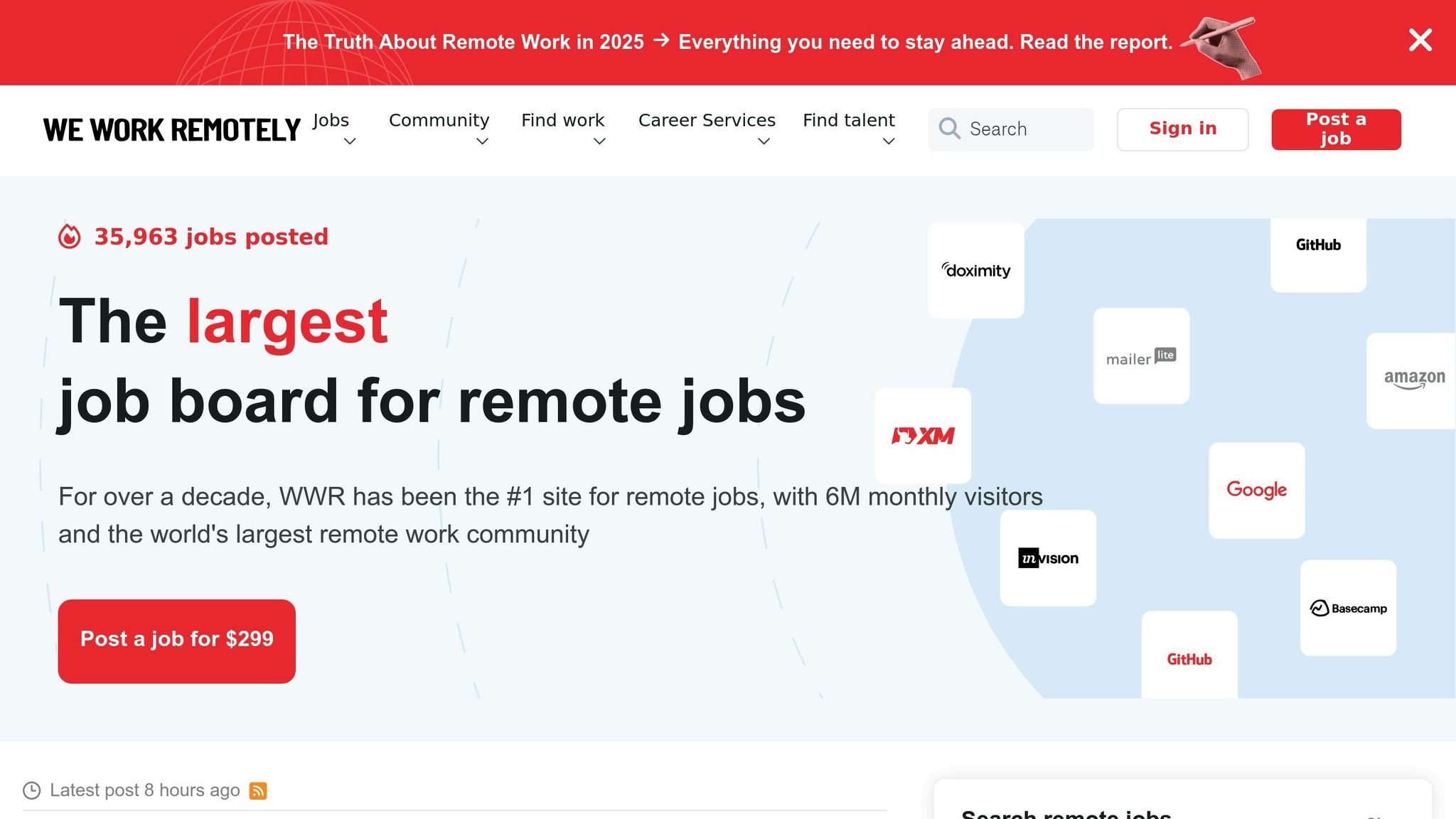
We Work Remotely (WWR) connects backend developers with companies that embrace remote work, drawing in over 6 million visitors each month and featuring more than 1,000 new job postings monthly [34]. With this impressive reach, WWR stands out as a platform that prioritizes quality and efficiency in job listings.
Focused Listings for Backend Developers
To ensure the quality of its listings, WWR charges employers $299 per month to post jobs. This fee helps weed out scams and low-quality postings [34]. Additionally, WWR amplifies visibility by redistributing job listings to popular networks like Unicorn Hunt, Google Jobs, and SitePoint [33]. Every position listed is remote-friendly, keeping the platform’s focus sharp and relevant.
Streamlined Search Features
WWR’s advanced filtering tools make it easy for developers to find roles that fit their needs. Job seekers can refine searches by categories, regions, time zones, company size, industry, job type, and even years of remote experience. Recognizing how overwhelming it can be to sift through countless remote jobs, WWR’s search options simplify the process with keyword and category filters [32].
A Truly Global Platform
Operating in 99% of countries worldwide [34], WWR caters to a diverse audience of job seekers. As a remote-first company itself, WWR understands the unique challenges of remote work and designs its features to support seamless collaboration for distributed teams.
Accessibility and Perks for Job Seekers
WWR offers free access to job seekers, even without an account. However, signing up for a free Basic Job Seeker account unlocks additional perks like job-saving features, personalized feeds, and a free resume review [34]. While users appreciate the platform’s exclusive focus on remote jobs and its user-friendly design, some have noted the lack of integrated communication tools for connecting directly with employers [33].
Platform Comparison Table
Here's a quick look at the key features, pricing, and pros and cons of various platforms tailored for backend developers. This table provides a snapshot to help you decide which platform suits your needs.
| Platform | Key Features | Pricing (Job Seekers) | Pricing (Employers) | Best For | Pros | Cons |
|---|---|---|---|---|---|---|
| Remote Jobs For Software Engineers | 50+ vetted job boards, custom filters, daily updates, centralized directory | Free to Pro ($19/month) | N/A | All backend developers | Centralized access, curated listings, multiple tiers | Newer platform |
| Toptal | Elite network, rigorous screening, high-paying clients | Free | Commission-based | Senior developers | Premium clients, high rates, quality projects | Difficult acceptance process |
| Wellfound | Startup focus, direct founder contact, equity information | Free | Subscription-based | Startup enthusiasts | Direct communication, equity details, salary transparency | Limited to startups |
| Arc.dev | Vetted developers, project matching, long-term contracts | Free | Commission-based | Mid to senior developers | Quality matching, professional support | Screening required |
| Built In | Tech company focus, salary insights, company culture information | Free | Subscription-based | Tech-focused developers | Industry insights, company details | Limited remote-only focus |
| Upwork | Freelance marketplace, project-based work, skill tests | Free (service fees apply) | Project fees | Freelancers | Large client base, flexible work | High competition, fee structure |
| Fiverr | Gig-based services, fixed pricing, quick turnaround | Free (service fees apply) | Project fees | Service providers | Easy setup, defined services | Race to bottom pricing |
| Professional network, recruiter access, industry connections | Free to Premium | Subscription-based | All professionals | Networking opportunities, recruiter visibility | Generic platform | |
| Stack Overflow Jobs | Developer community, technical focus, reputation system | Free | Per posting | Technical developers | Developer-centric, community trust | Limited remote filtering |
| We Work Remotely | Remote-only focus, quality listings, global reach | Free | $299/month per posting | Remote-first developers | 100% remote jobs, quality control | Limited communication tools |
Pricing Models and Quality Control
The cost structures across these platforms vary significantly. For example, We Work Remotely charges employers $299 per job posting for 30 days, while Remote Jobs For Software Engineers offers a free tier alongside a Pro plan for $19/month. Platforms like Arc.dev and Wellfound stand out by providing free access for job seekers while monetizing through employer fees or commissions.
Quality control is another differentiator. We Work Remotely, for instance, uses its posting fee to filter out lower-quality listings, boasting an impressive 90% fill rate for posted positions [35]. Similarly, platforms like Arc.dev focus on vetting developers to ensure a strong match between talent and employers.
Salary Transparency and Additional Features
For backend developers who value upfront salary information, platforms like Wellfound and Arc.dev are excellent choices, as they prominently display compensation ranges. This transparency can save time and streamline the job search process.
"These platforms cut through the noise, delivering quality roles across industries." - Nelson Marteleira, Co-founder, NoCode Institute [1]
The diversity in platform features and pricing models ensures that there’s something for everyone, whether you’re a freelancer, a senior developer, or someone looking for startup opportunities. Take your career goals into account and choose the platform that aligns with your priorities.
Conclusion
Landing the perfect remote backend role takes a thoughtful and strategic approach, using a mix of platforms to your advantage. Each platform brings something different to the table - Remote Jobs For Software Engineers aggregates over 50 carefully vetted boards, Toptal connects you with high-end clients, and We Work Remotely focuses exclusively on remote opportunities.
As of December 2023, only 10% of LinkedIn job postings were for remote roles, but those listings attracted a staggering 46% of applications [14]. Remote work continues to show its appeal, with reported productivity boosts of 35–40% and a 79% reduction in stress levels. These benefits translate into better work-life balance and competitive pay [36]. These numbers highlight why a well-rounded job search strategy is essential.
To make the most of your search, tap into multiple platforms. Specialized boards like Arc.dev offer curated opportunities, Wellfound highlights startup roles with equity details, and general platforms like LinkedIn are ideal for networking. Avoid relying on just one or two sources - cast a wide net to maximize your chances.
But success isn’t just about where you search. It’s equally important to optimize your online presence. Highlight your remote work skills, showcase a strong project portfolio, and attend virtual events to grow your network. Keep in mind that 70% of jobs are never posted publicly, and 85% are filled through referrals [37]. Building relationships is just as crucial as applying for positions.
When applying, always verify the legitimacy of a company by reviewing their online presence and reading feedback from others [14]. Be cautious of postings that require upfront payments and prioritize listings with clear job descriptions and qualifications. The average job search takes about five months [37], so stay persistent and use a variety of tools and strategies to land the remote backend role that’s right for you.
FAQs
::: faq
What features should you prioritize when choosing a remote backend job board?
When choosing a remote backend job board, focus on features that make your search easier and more efficient. Look for tools like advanced filters to refine job listings based on your preferences, custom job alerts to keep you informed about new postings, and a simple, intuitive interface that’s easy to navigate. Extras like resume management tools, employer connection portals, and detailed insights can also help streamline your hunt for the perfect role. :::
::: faq
How do platforms like Toptal and Arc.dev maintain high-quality job listings for backend developers?
Platforms like Toptal and Arc.dev stand out by offering top-tier job listings for backend developers, thanks to their strict screening processes. These platforms meticulously evaluate both developers and employers to ensure that only skilled professionals and trustworthy companies make the cut.
Their process often involves multiple interview stages, in-depth skill assessments, and portfolio evaluations. This careful matching ensures developers are connected with roles that genuinely fit their skill set, maintaining high standards for the opportunities available. :::
::: faq
What are the best strategies for backend developers to secure a remote job using these platforms?
How to Boost Your Chances of Getting a Remote Backend Role
If you're aiming for a remote backend developer position, focusing on the right areas can make all the difference. Start by sharpening your technical skills - mastering popular programming languages like Java, Python, or Ruby can make you stand out. Companies often look for developers with senior-level experience, as it signals reliability and expertise, which are especially critical for remote roles.
Your resume and portfolio should work hard for you. Highlight projects that showcase your abilities, especially those relevant to backend development. Tailor your applications to match the specific requirements of each job. Using platforms designed for tech professionals can also help you find positions aligned with your career goals. Don’t forget the power of networking - connecting with others in developer communities can lead to valuable opportunities. And if you're applying for international roles, ensure you have any necessary documentation ready to simplify the process.
Lastly, set yourself up for success by preparing your remote work environment. A dependable internet connection and tools like code editors, communication platforms, and project management software will show employers you're ready to collaborate effectively from anywhere. :::

